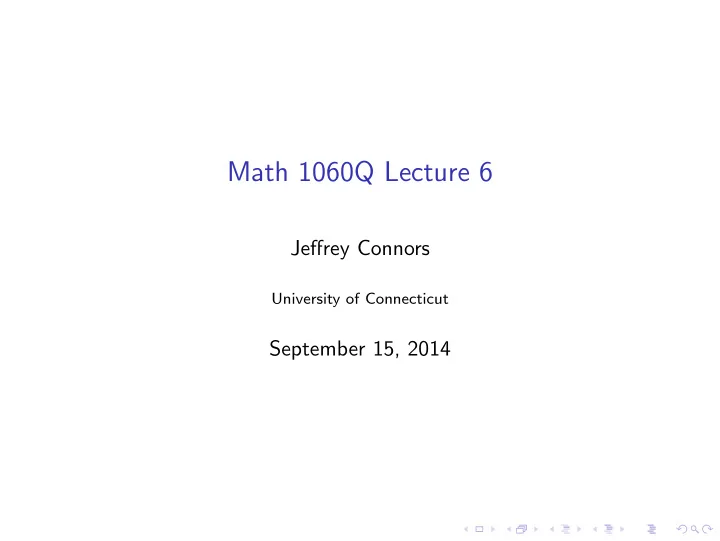

Math 1060Q Lecture 6 Jeffrey Connors University of Connecticut September 15, 2014
Today we explore some special functions. ◮ Shifts, stretches and flips of graphs ◮ Absolute value function ◮ Square root function ◮ Greatest integer function ◮ Domain and range problems
Recall from last lecture: shifts of graphs and vertical stretches ◮ f ( x ) + c , c > 0: push graph “up” c units ◮ f ( x ) − c , c > 0: push graph “down” c units ◮ f ( x + c ), c > 0: move graph to left c units ◮ f ( x − c ), c > 0: move graph to right c units ◮ cf ( x ): shrink (0 < c < 1) or stretch (1 < c ) vertically by a factor of c
We can shrink or stretch horizontally by rescaling the argument ◮ f ( cx ), 0 < c < 1: stretch horizontally ◮ f ( cx ), c > 1: shrink/compress horizontally
We can flip across the x -axis or the y -axis as well ◮ f ( − x ): flip across y -axis ◮ − f ( x ): flip across x -axis
◮ Shifts, stretches and flips of graphs ◮ Absolute value function ◮ Square root function ◮ Greatest integer function ◮ Domain and range problems
The basic shape of f ( x ) = | x | is a “V“. Note the domain and range.
Now we can manipulate the graph via shifts, flips and stretches
◮ Shifts, stretches and flips of graphs ◮ Absolute value function ◮ Square root function ◮ Greatest integer function ◮ Domain and range problems
The square root function: note the shape, domain, range.
Manipulations of the square root function
◮ Shifts, stretches and flips of graphs ◮ Absolute value function ◮ Square root function ◮ Greatest integer function ◮ Domain and range problems
The greatest integer or “floor” function: note domain and range.
What is interesting is to stretch horizontally.
◮ Shifts, stretches and flips of graphs ◮ Absolute value function ◮ Square root function ◮ Greatest integer function ◮ Domain and range problems
You will want to be able to answer questions as in these examples. Example L6.1: What are the domain and range of √ x − 1? f ( x ) = 1 2 Solution: You need what is under the “radical” to be non-negative: x − 1 ≥ 0 ⇒ x ≥ 1 . Therefore, the domain is [1 , ∞ ). For the range, the coefficient 1 2 does not matter. There is no vertical shift; the range is [0 , ∞ ), just like for √ x . Example L6.2: What are the domain and range of f ( x ) = | 2 x + 1 | − 1? Solution: You should think of this as f ( x ) = | 2( x + 1 / 2) | − 1. This function is generated from | x | by shifting left 1 / 2 unit, contracting horizontally by a factor of 2 and shifting down one unit. Therefore, the domain is still R and the range is [ − 1 , ∞ ).
Similar examples. Example L6.3: What are the domain and range of f ( x ) = floor( x − 1 / 3) − 1? Solution: Shifting horizontally does nothing to affect the domain, which is R . Shifting vertically by an integer does not affect the range; it is all integers: Z . Example L6.4: What are the domain and range of f ( x ) = 1 2 floor( x )? Solution: The domain is the same as before; the range is now: � � x | x = k R = 2 , k is an integer .
Practice! Problem L6.1: Sketch the graph of f ( x ) = √ x + 2 − 3. Problem L6.2: Sketch the graph of f ( x ) = −| x − 3 | + 1. Problem L6.3: Sketch the graph of f ( x ) = floor( x + 1). Problem L6.4: Sketch the graph of f ( x ) = | 5 x − 5 | . Problem L6.5: Find the domain and range of f ( x ) = − 2 √ x + 4. Problem L6.6: Find the domain and range of f ( x ) = | x | + 3.
Recommend
More recommend